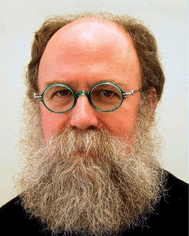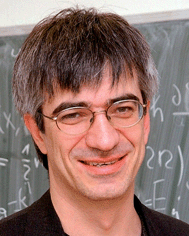Editorial for Synchrotron Radiation
Alex von Bohlen and Metin Tolan
Institute for Analytical Sciences, Technische Universität Dortmund, Germany
 Alex von Bohlen |
 Metin Tolan |
Historically, users of synchrotron radiation (SR) were often placed in the family of parasites, homo spectroscopicus παρασιτοζ. They started to develop a new species of scientists at large accelerators constructed for atomic physics, used e.g. for high energy collision experiments. The new species applied the highly brilliant radiation emerging from those machines and they recognised the potential offered to physicists, chemists, geologists, physicians, biologists, engineers and art historians. The benefits of SR in all disciplines of application are unequalled. Strictly, the so-called SR is obtained from a storage ring in which the electrons or positrons are stored and maintained at constant velocity of some GeV (109 eV). They do not undergo an additional acceleration as is usual in a synchrotron. The radiation emerges tangentially to the orbit of highly accelerated (relativistic) electron or positron bunches deflected by strong magnetic fields. SR covers a wide range of the electromagnetic spectrum from infrared radiation to hard X-rays.
Furthermore, the radiation is pulsed, strongly collimated and highly polarized (linear in the orbit plane of electrons and elliptical off plane). Usually, a small bandwidth of the white radiation is selected to perform experiments with quasi monochromatic radiation. The high brilliance of SR sources (cf.Fig. 1) allows many experiments at the micro- and nano-scale, with lateral resolution and/or spectral resolution not known beforehand. Many experiments, e.g. in the field of time resolved spectroscopy, surface and interface analysis, and nano 3D imaging via tomography, are possible. The pulsed SR can be tuned in certain margins while the emitted radiation can be completely calculated. This fact makes SR an excellent tool for (absolute) calibration tasks.
 | ||
| Fig. 1 Brilliance of SR at some synchrotron facilities. | ||
Nowadays, synchrotrons specially constructed to produce the radiation to be applied in a variety of experiments in a broad field of applications are available. The size and performance of more than fifty machines spread over the whole world can be seen online, e.g.http://www.lightsources.org.
Papers contained in this issue cover a wide range of applications. A review dealing with SR-TXRF by Christina Streli et al. presents the potential of the well-known advantages of TXRF. The absolute detection limits reach the fg = 10−15 g. Burkhard Beckhoff discusses in his contribution the reference-free quantification of SR induced X-ray fluorescence. Three articles present typical studies: in chemistry by Andrea Hamilton and Christopher Hall; in physics by Christian Sternemann, and in biology/environmental sciences by Lazlo Vincze et al. are the best examples for modern research in the natural sciences. Would it be possible to find a satisfactory answer without the use of SR? Birgit Kanngiesser, Marie Cotte and Ina Reiche make use of the complete ‘orchestra’ available for the analyses of objects of cultural heritage. Micro imaging, 3D micro X-ray fluorescence, XANES and XRF are the methods of choice for the characterisation of historical paintings, historical glasses, pigmented paleontological and archaeological bones. Nevertheless, there are many more options and methods offered by numerous facilities around the world.
If we spend a minute to review published articles containing the word ‘synchrotron’ the distribution along the timescale shows a discontinuity in 1991. The total number of publications obtained from an ‘ISI Web of Science’ search under ‘synchrotron’ was 36![[thin space (1/6-em)]](https://www.rsc.org/images/entities/char_2009.gif) 738 by the end of February 2008. The distribution is represented by the vertical blue bars in Fig. 2. The orange bars represent a combined search for ‘synchrotron and spectroscopy’. Both graphs show in 1991 a dramatic increase of publishing activities. It is connected to the construction of three large facilities of the 3rd generation: ESRF, Grenoble, France; APS, Argonne, USA; and SPring-8, Hyogo, Japan. The construction was finished in 1994, 1996, and 1997 respectively (horizontal green line), while ESRF started with users in 1994 (horizontal blue line). APS and SPring-8 were later. This year, 1991, was the crucial point in the evolution.
738 by the end of February 2008. The distribution is represented by the vertical blue bars in Fig. 2. The orange bars represent a combined search for ‘synchrotron and spectroscopy’. Both graphs show in 1991 a dramatic increase of publishing activities. It is connected to the construction of three large facilities of the 3rd generation: ESRF, Grenoble, France; APS, Argonne, USA; and SPring-8, Hyogo, Japan. The construction was finished in 1994, 1996, and 1997 respectively (horizontal green line), while ESRF started with users in 1994 (horizontal blue line). APS and SPring-8 were later. This year, 1991, was the crucial point in the evolution.
 | ||
| Fig. 2 Publications containing‚ ‘synchrotron' listed in the ISI Web of Science. | ||
An increasing number of larvae mutated from the early stadium of parasites into brilliant scientists, homo spectroscopicus συγχρονοζ. The small selection of results obtained by applying synchrotron radiation in research presented in this special issue of JAAS is intended to encourage you to belong to the new species. Today we have no more reason to belong to an exotic group of users. We are a modern family and an innovative community.
| This journal is © The Royal Society of Chemistry 2008 |
